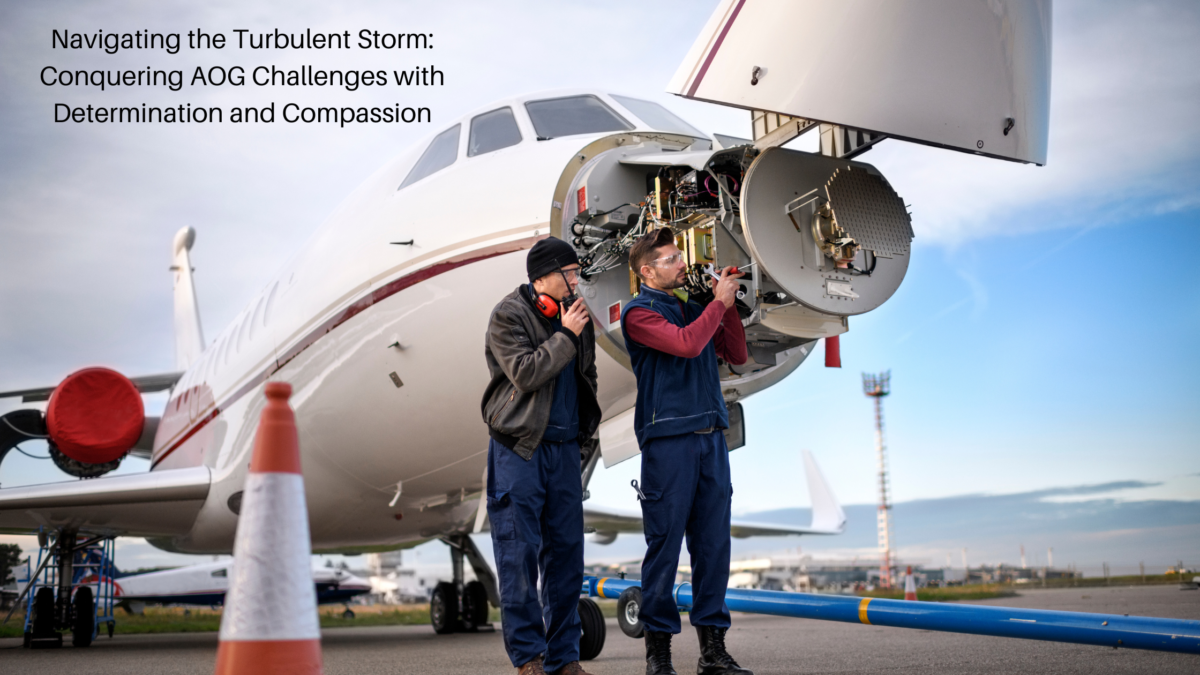Navigating the Turbulent Storm: Conquering AOG Challenges
Navigating the Turbulent Storm: Conquering AOG Challenges with Determination and Compassion
Facing an Aircraft on Ground (AOG) situation for a private jet requires swift and efficient action to minimize downtime and get the aircraft back in the air. Here are essential steps to handle a private jet AOG situation effectively:
1. Notify the Maintenance Provider Contact your maintenance provider immediately and inform them about the AOG situation. Provide all relevant details, including the aircraft type, issue nature, and current location.
2. Request AOG Support Activate the AOG support team of your maintenance provider. Many providers have specialized teams to handle AOG situations and offer necessary assistance.
3. Define the Problem Collaborate closely with the maintenance provider to diagnose the issue accurately. They may ask for additional details or request specific checks or tests to identify the problem.
4. Ensure Spare Parts Availability Inquire about the availability of required spare parts. If not available at the current location, consider shipping from another location or sourcing from a nearby facility.
5. Arrange for Technical Support If the issue exceeds your maintenance provider’s capabilities, they might recommend technical support from the aircraft manufacturer or a specialized vendor. Coordinate to ensure they have the required information and aircraft access.
6. Consider Temporary Solutions Explore temporary repairs or workarounds to get the aircraft back in service until a permanent fix can be implemented. Consult with your maintenance provider for guidance.
7. Coordinate Logistics During repairs, arrange accommodations for passengers and crew, transportation, and other support services. Maintain clear communication with all stakeholders, including passengers and crew members.
8. Follow-up and Updates Stay in constant communication with your maintenance provider and track repair progress. Regularly update passengers, crew, and other affected parties about the situation, timelines, and necessary changes.
9. Quality Assurance After repairs, conduct thorough inspections and quality assurance checks to ensure the aircraft is in proper working condition and meets safety standards. Verify all necessary paperwork and documentation.
10. Implement Preventive Measures Analyze the root cause of the issue and take preventive measures to minimize future occurrences. This may involve maintenance process improvements, component reliability assessments, or other corrective actions.
How to Handle Clients During an AOG Situation
Managing and communicating with clients during an AOG situation is crucial. Here are guidelines for effective client handling:
1. Promptly Inform the Clients Immediately inform clients about the AOG situation. Provide accurate information about the issue, expected downtime, and changes to travel plans. Prompt communication builds trust and manages expectations.
2. Offer Alternatives Present clients with alternative travel options, such as substitute aircraft, commercial flights, or charter services from other operators. Assist them in making necessary arrangements and be flexible to their needs.
3. Provide Regular Updates Maintain open communication with clients throughout the AOG situation. Keep them informed about repair progress, timeline changes, and other relevant updates. Regularly address any concerns or questions they may have.
4. Offer Concierge Services Provide concierge services to clients, including assistance with rebooking hotels, ground transportation, or other travel-related arrangements. This level of support demonstrates commitment to client satisfaction.
5. Maintain Professionalism Handle client interactions with professionalism and empathy. Understand their frustration or inconvenience, listen attentively to their concerns, and address them promptly and courteously.
6. Consider Compensation Evaluate the severity and duration of the AOG situation and consider compensation for clients if appropriate. Offer gestures of goodwill as a token of apology for the inconvenience caused.
7. Keep Clients Informed of Resolution Once resolved, inform clients about the successful repair and aircraft readiness. Reconfirm travel plans and offer assistance in rescheduling flights or making additional arrangements.
8. Post-AOG Follow-up Follow up with clients after resolving the AOG situation to ensure satisfaction and address any remaining concerns. This post-AOG support helps maintain positive relationships and demonstrates commitment to their satisfaction.
“A swift response and clear communication are the wings that lift you above any AOG situation.”
Preparing for AOG Situations
Preparation is crucial for unexpected AOG situations. Here are additional considerations:
1. Emergency Response Plan Develop an emergency response plan tailored to handle AOG situations. Outline steps, contact information for maintenance providers, vendors, technical support, and protocols for client communication and support.
2. 24/7 Availability Ensure a system to handle AOG situations around the clock. Maintain contact information for key personnel, including maintenance providers, technical experts, and support staff. Consider establishing a dedicated hotline for AOG emergencies.
3. Rapid Response Network Build a network of reliable maintenance providers, vendors, and technical experts for quick responses. Establish relationships with multiple service providers in different locations to increase timely support chances.
4. Spare Parts Inventory Maintain an inventory of critical spare parts for your aircraft fleet. Work closely with maintenance providers to identify essential parts and ensure they are readily available, expediting repairs and minimizing downtime.
5. Remote Monitoring and Diagnostics Utilize advanced technologies and remote monitoring systems for real-time aircraft performance insights. Identify potential issues early and allow proactive maintenance, reducing AOG situation risks.
6. Regular Maintenance and Inspections Adhere to a strict maintenance schedule and conduct regular inspections to detect and address potential issues before they lead to AOG situations. Implement preventive maintenance measures and stay updated with recommended service bulletins and airworthiness directives.
7. Training and Knowledge Sharing Invest in ongoing training for maintenance staff and flight crew to enhance technical skills and knowledge. Encourage knowledge sharing and open communication between teams involved in aircraft operation and maintenance, improving problem-solving abilities during AOG situations.
8. Continuous Improvement Conduct post-mortem analysis after each AOG situation to identify improvement areas in processes, systems, and response protocols. Learn from past experiences and implement changes to prevent or better handle similar situations in the future.
While eliminating AOG situation risks is impossible, proactive, prepared, and responsive measures can significantly mitigate impacts and ensure efficient resolution. Continuously improving systems and processes equips you better to handle unexpected AOG situations.
For private jet and helicopter charter requirements, please contact us at info@safefly.aero.
Visit our website: www.safefly.aero




